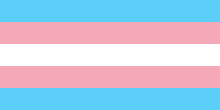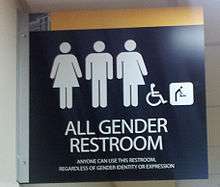Unisex public toilet
| Part of a series on |
| Transgender topics |
|---|
 |
| Identities |
| Topics |
| Attitudes |
| Legal issues |
| Lists |
|
|
A unisex public toilet, alternatively called a unisex bathroom, unisex lavatory, gender-inclusive toilet, gender-neutral public toilet,[1] gender-neutral washroom,[2][3] or often shortened to just unisex toilet[4] or unisex restroom is a public toilet that people of any gender or gender identity may use. Gender-neutral bathrooms benefit transgender populations and other people who exist outside of the gender binary; people with disabilities, the elderly, and anyone else who may require the assistance of someone of another gender; and parents who may wish to accompany their children to the washroom or toilet facility.[5][6][7]
According to Dalhousie University, Canada: "A gender-neutral washroom is one where the signage is visibly identified with open, inclusive language, not just male or female. It's evident these facilities are void of gender identity and have accommodations that are especially sensitive to the needs of a greater range of people. Some people are not comfortable using male or female-designated washrooms."[8]
History of segregated restrooms
Making public facilities accessible to diverse populations has long been a divisive issue. Gender segregated restrooms in the United States and Europe are a vestige of the Victorian era where women's modesty and safety were considered at risk and under constant need of surveillance and discipline. While public water closets were considered necessary for sanitation reasons, they were viewed as offending public sensibilities. Because public facilities were associated with access to public spaces, extending these rights to women was viewed as "immoral" and an "abomination".[9] While some public facilities were available to women in London by 1890, there were much fewer than those available to men.[10][11]
Historically in the United States, Europe, and elsewhere public toilets have been segregated by race, class, religion, and gender, and have frequently been completely inaccessible to certain people with disabilities.[12][13] In the United States, during Jim Crow, public washrooms were racially segregated in part to protect the morality and sensibilities of white women.[14] [15]
Gender neutral bathroom legislation
United States
The Equal Employment Opportunity Commission provides federal anti-discrimination protections on the basis of race, color, religion, national origin, sex, pregnancy status, age, disability, and genetic information.[16] However, federal anti-discrimination laws do not extend to LGBT individuals. While the U.S. Department of Education has indicated that single-sex schools must treat transgender students consistent with their gender identity under Title IX, they have not extended such a ruling to transgender students across the board.[17] Each state, county, and city government enacts its own legislation governing how it will or will not protect the rights of LGBT individuals; this includes provision of gender neutral bathrooms.
The United States Department of Labor's Occupational Safety and Health Administration (OSHA) requires that employers provide accessible toilets for all employees, and that employers do not impose "unreasonable restrictions" on employees who wish to use bathrooms at work. However, this federal requirement for employers applies mainly to the physically disabled, and to women employed in male-dominated workplaces. OSHA historically has not applied this law to transgender employees.[18]
San Francisco, Philadelphia, Seattle, Washington D.C., West Hollywood, and Austin have each passed measures mandating that single-occupancy bathrooms in public spaces be relabeled as gender-neutral.[19] Meanwhile, state legislatures in Arizona, Illinois, Kansas, Kentucky, Massachusetts, Minnesota, Mississippi, Missouri, South Carolina, and Tennessee currently have anti-transgender bills on the floor that would restrict bathroom access.[20]
The Human Rights Campaign recommends that employers grant access, and use, to bathrooms according to an employee's "full time gender presentation", and provides a list of recommendations for employers on how to do so.[21]
California became the first state to require all single-occupancy bathrooms to be gender-neutral from March 1, 2017.[22][23]
Justification for signage of all-gender restrooms
All-gender restrooms are designed to ensure that restrooms are fully accessible to all members of society. While the issue of gender inclusive restrooms has been raised as an equity and human rights issue for people who identify outside of the gender binary, eliminating gender segregation in bathrooms also benefits disabled populations who may have attendants of a different gender, parents with children, and anyone who may need additional assistance using public toilet facilities. For gender-variant people and others who identify or are perceived to be outside the gender binary, A-Gender restrooms can eliminate discrimination and harassment for people who may be perceived to be in the "wrong" bathroom.[7] One survey of transgender populations conducted in Washington, DC, by the group DC Trans Coalition, "found that 70 percent of survey respondents report experiencing verbal harassment, assault, and being denied access to public restrooms.[7]" It also found that "54 percent of all respondents reported having some sort of physical problem from trying to avoid using public restrooms, such as dehydration, kidney infections, and urinary tract infections" making access to safe restrooms a public health issue.[7][24]
Advocacy and inclusion leadership

In the United Kingdom, all-gender restrooms are sometimes found on university campuses. In early 2013, Brighton and Hove city council introduced unisex toilets, which did not feature the words 'men/gentlemen' or 'women/ladies' (as is traditional), but instead used 'universal symbols', which was described as 'political correctness' by the Daily Mail.[1]
In April 2014, the Vancouver Park Board decided to install all-gender restrooms in public buildings, with different signs to identify them. Amongst the options discussed was the rainbow triangle (based on the pink triangle used during the Holocaust), an 'all-inclusive' gender symbol, an icon representing a toilet or the phrases 'washroom' or 'gender-neutral washroom' placed on the entrances to the toilets. According to Global News, a Canadian online newspaper, many different regions across Canada offer unisex toilets and other gender-neutral facilities, but Vancouver was the first municipality to change building codes to require unisex toilets be built in public buildings. This movement, according to commissioner Trevor Loke, was aimed to make everyone feel welcomed and included: "We think that the recommendation of universal washrooms is a good idea [...] [w]e will be using more inclusive language based on the BC Human Rights Code." Some initiatives to make washrooms more diverse and inclusive have focused on language simply by using the phrases 'washroom' or 'gender-neutral washroom' in order to be inclusive of all genders and gender identities, or using specifically geared language such as 'women and trans women' as opposed to just 'women' (and vice versa for men and trans men). [2][3]
All-gender restrooms on college campuses

Recently, there has been a growing trend on college campuses in the US to establish all-gender public restrooms. Many campuses are renaming existing restrooms and toilets in order to be more inclusive. According to a study by the University of Massachusetts, there are over 150 college campuses across the US that are creating gender-neutral restrooms. Safety concerns have prompted many colleges to take action to implement non-gendered bathrooms. Activists, who are trying to get more gender-neutral restrooms on college campuses, hope that everyone, not just gendered individuals, can feel safe.[25]
Research by the University of Massachusetts comments on the need for gender neutral restrooms and the issue of safety. It says that certain people feel threatened using facilities that do not adhere to their gender identity, and this can become an issue when students are harassed by their peers. The University states that this is more of an issue in restrooms that are designated for male use than those that are designated for female use.[26]
According to a research article by Olga Gershenson of the University of Massachusetts Amherst, restrooms have always been an issue for one group or another. First, women around the world petitioned for the right to their own facilities; next were racial minorities in the US during the time of segregation. After this fight, people with disabilities raised the issue to get fully equipped facilities. That fight ended with changes to building codes to make washroom more accessible. Now the issue concerns transgender and other gender variant people.[27]
The University of Oklahoma continually adds gender-neutral restrooms to their campus to accommodate students who may require use of a less excessively gendered bathroom. (Students that fit under this umbrella may identify as LGBTQIA+). As of February 2014, the university had 13 unisex bathrooms.[28] Recently, the university has vowed to include a gender neutral bathroom in all new buildings to be constructed.
| Wikimedia Commons has media related to Unisex toilet signs. |
References
- 1 2 "Brighton Council to open 'gender neutral' public toilets as it 'phases out male and female lavatories'". dailymail.co.uk. London: The Daily Mail. 18 February 2013. Retrieved 20 December 2014.
- 1 2 Judd, Amy. "Vancouver Park Board votes to install gender-neutral washrooms". globalnews.ca. Global News. Retrieved 20 December 2014.
- 1 2 Judd, Amy. "Vancouver Park Board asking for input on universal washrooms and signage". globalnews.ca. Global News. Retrieved 20 December 2014.
- ↑ Roberts, Rachel (21 March 2014). "Unisex toilets in schools should be avoided at all costs". independent.co.uk. London: The Independent. Retrieved 20 December 2014.
- ↑ Anthony, Kathryn H.; Dufresne, Meghan (2007-02-01). "Potty Parity in Perspective: Gender and Family Issues in Planning and Designing Public Restrooms". Journal of Planning Literature. 21 (3): 267–294. doi:10.1177/0885412206295846. ISSN 0885-4122.
- ↑ Bellware, Kim. "Gender-Neutral Bathrooms Are Quietly Becoming The New Thing At Colleges". Huffington Post. Retrieved February 27, 2016.
- 1 2 3 4 Herman, Jody. “Gendered Restrooms and Minority Stress: The Public Regulation of Gender and Its Impact on Transgender People’s Lives – ProQuest.” University of California, Los Angeles: The Williams Institute, June 2013. http://williamsinstitute.law.ucla.edu/wp-content/uploads/Herman-Gendered-Restrooms-and-Minority-Stress-June-2013.pdf.
- ↑ "Gender-Neutral Washrooms". dal.ca. Dalhousie University. Retrieved 20 December 2014.
- ↑ Greed, Clara. Inclusive Urban Design: Public Toilets. Routledge, 2007.
- ↑ Penner, Barbara. Bathroom. Reaktion Books, 2013. p. 69.
- ↑ Suk, Jeannie. “Who’s Afraid of Gender-Neutral Bathrooms?” The New Yorker, January 25, 2016. http://www.newyorker.com/news/news-desk/whos-afraid-of-same-sex-bathrooms.
- ↑ Molotch, Harvey, and Laura Noren, eds. Toilet: Public Restrooms and the Politics of Sharing. New York: NYU Press, 2010.
- ↑ Penner, Barbara. Bathroom. Reaktion Books, 2013.
- ↑ Frank, Gillian. “The Anti-Trans Bathroom Nightmare Has Its Roots in Racial Segregation.” Slate, November 10, 2015. http://www.slate.com/blogs/outward/2015/11/10/anti_trans_bathroom_propaganda_has_roots_in_racial_segregation.html.
- ↑ Godfrey, Phoebe. “Bayonets, Brainwashing, and Bathrooms: The Discourse of Race, Gender, and Sexuality in the Desegregation of Little Rock’s Central High.” The Arkansas Historical Quarterly 62, no. 1 (April 1, 2003): 42–67.
- ↑ "Laws Enforced by EEOC." Retrieved from http://www.eeoc.gov/laws/statutes/index.cfm
- ↑ Steinmetz, Katy. "Feds Say Transgender Students' Gender Identity Must Be Respected." Time, 2014-12-03. Retrieved from http://time.com/3614567/transgender-students-gender-identity-deserves-respect-feds-say/
- ↑ United States Department of Labor, Occupational Safety & Health Administration. "Interpretation of 29 CFR 1910.141(c)(1)(i): Toilet Facilities." Retrieved from https://www.osha.gov/pls/oshaweb/owadisp.show_document?p_table=INTERPRETATIONS&p_id=22932
- ↑ Steinmetz, Katy. "The Gender-Neutral Bathroom Revolution Is Growing." Time. 2016-01-11. Retrieved from http://time.com/4175774/san-francisco-gender-neutral-bathrooms/
- ↑ National Center for Transgender Equality. "Take Action Against Anti-Trans Legislation Now!" Retrieved from http://www.transequality.org/action-center#Hawaii
- ↑ Human Rights Campaign. "Restroom Access for Transgender Employees." Retrieved from http://www.hrc.org/resources/restroom-access-for-transgender-employees
- ↑
- ↑
- ↑ Penner, Barbara. Bathroom. Reaktion Books, 2013.
- ↑ Bellware, Kim (18 July 2014). "Gender-Neutral Bathrooms Are Quietly Becoming The New Thing At Colleges". huffingtonpost.com. The Huffington Post. Retrieved 20 December 2014.
- ↑ Beemyn, Genny. "Gender-Neutral Restrooms" (PDF). umass.edu. Stonewall Center, University of Massachusetts. Retrieved 20 December 2014.
- ↑ Gershenson, Olga. "January 2010 The Restroom Revolution: Unisex toilets and campus politics". works.bepress.com. University of Massachusetts – Amherst.
- ↑ "Gender-neutral restrooms create a safe place for all people". OUDaily.com. Retrieved 2015-10-23.
External links
| Library resources about Unisex public toilet |
- Directory of gender neutral toilets
- Searchable database of family restroom locations
- Queens University – Gender Neutral Washroom Policy
- Canoe.ca – UWO opens transgendered washrooms
- Canada.com – A revo-loo-tion on the UBC campus
- Unisex or Gender Neutral Toilets - the Facts Some facts about unisex or gender neutral toilets
